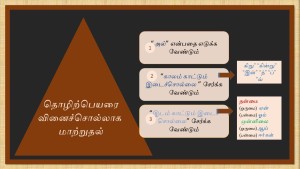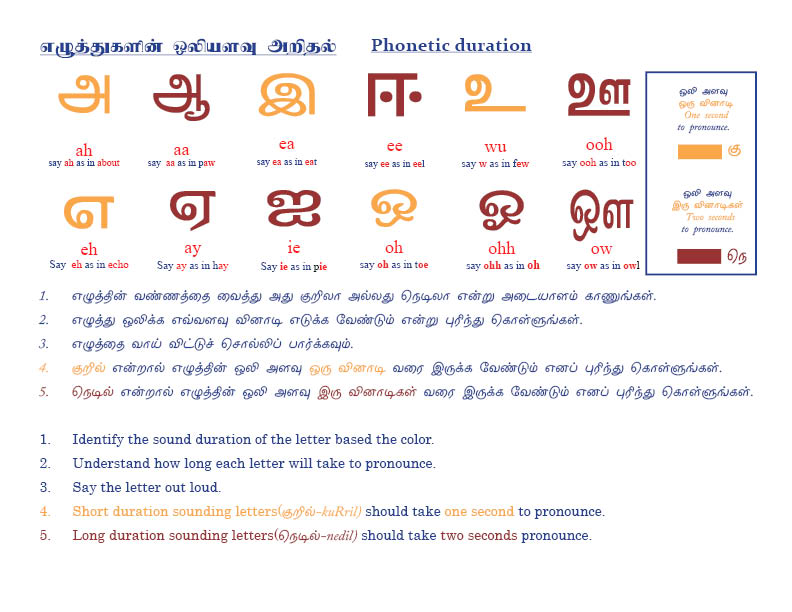இடைச்சொல்- பாடம்
தொடக்க நிலைப் பாடத்தில் நாம் இடைநிலைச் சொற்களைப் பார்க்கப் போகிறோம். இவை தனியாக நின்று பொருள் தராது. அவை பெயர்ச்சொல்லின் இறுதியில் சேர்ந்து பொருள் தரும் ஒரு இடைநிலைகளைப் பயன்படுத்தத் தெரிந்தால் தமிழ்ல் பொருள் தரும் சொற்றொடர்களை அமைக்க முடியும். இந்த இடைநிலைகளைக் கொண்டு தொழிலைக் குறிக்கும் பெயர்சொற்களை வினைச்சொல்லாகவும் மாற்றலாம்.
தொடக்க நிலையில் இடைநிலை சொற்களை இரு வகையாகப் பிரிக்கலாம்.
காலம் காட்டும் ஈறுகள்
இடம் காட்டும் இடைநிலைகள்,
ஏற்கனவே காலம் காட்டும் இடைநிலைகள் இந்தச் சுட்டியில் கொடுக்கப் பட்டுள்ளது.
அவையாயாவன,இன்” “ட்”ற்”“த்” “கிறு” “கின்று” ஆநின்று“ “ப்” “வ்
இன்” “ட்”ற்”“த்”ஆகியவை இறந்த காலத்தையும், “கிறு” “கின்று” ஆநின்று“ஆகியவை நிகழ்காலத்தையும் “ப்” “வ்
ஆகியவை எதிர்காலத்தையும் காட்டும்.
இடம் காட்டும் ஈறுகளைப் பார்ப்போம்
தன்மை இடம் (ஒருமை) ஏன்
(பன்மை)ஓம்
முன்னிலை இடம் (ஒருமை)- ஆய்
முன்னிலை இடம் (பன்மை) ஈர்கள்
நாம் முதலிலேயே பார்த்தபடி தன்மையும் முன்னிலை எந்தப் பாலையும் காட்டாது.ஆனால் தொழிலைக் குறிக்கும் பெயர்சொற்களோடு சேர்ந்து பெயர்ச்சொல்லை வினைச்சொல்லாக மாற்றும் ஒரு சொற்றொடர் அமைக்கும் போது பெயரைக் குறிக்கும் பெயர்ச்சொல்லை விட ஒரு வினைச்சொல்லே இடத்தையும் காலத்தையும் காட்டும்.
இங்கே நாம் தன்மை முன்னிலை இடங்களை வைத்துச் சில சொற்றொடர்களை அமைக்கலாம்.
முதலில் தொழில் பெயர்களை வினைச்சொல்லாக மாற்றலாம்.
அதன் படிகள்
- “அல்” என்பதை எடுக்க வேண்டும்
- “காலம் காட்டும் இடைச்சொல்லை”சேர்க்க வேண்டும்
- இடம் காட்டும் இடைச் சொல்லைச் சேர்க்க வேண்டும


- Particles have an important work in Tamil language even though they cannot give any meaning. Particles are also referred as in-between words in Tamil. In an elementary level the learners need to know two types of particles. They are particles that show tense. And point of view.இன்-in” “ட் it”ற் iRr”“த்(ith)” “கிறு(kiRu)” “(கின்று(kinduRu)” ஆநின்று(aaninRu)“ “ப்(ip)” “வ்(iv)
- Past tense particles areஇன்-in” “ட் it”ற் iRr”“த்(ith)”
- Present tense are “கிறு(kiRu)” “(கின்று(kinduRu)” ஆநின்று(aaninRu)”
- Future tense are “ப்(ip)” “வ்(iv)
Some particles show the point of view ending. They are “ஏன்yehen”ஓம்om””ஆய் aai” ஈர்கள்eergal”
First person singular- “ஏன்yehen”
First person plural- “ஓம்om”
Second person singular “ஆய் aai”
Second person plural ஈர்கள்eergal”
Changing the action nouns to verbs In Tamil
- Remove the“அல்
- Add the appropriate tense particle
- Add the appropriate point of view particle ending
Now play the game to reinforce the concept for first person past tense
[iframe_loader type=’iframe’ width=’100%’ height=’600′ frameborder=’0′ src=’http://tamilanitham.com/wp-content/uploads/articulate_uploads/pastenseGame8/story.html’]







You must be logged in to post a comment.